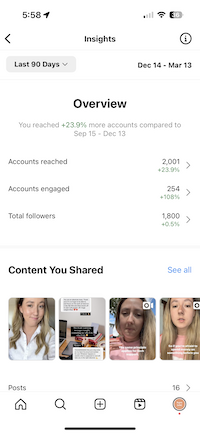I've lost a heap of followers, but I'm okay with that.
It’s been three months, almost to the day, since I had launched H&HM, and plunged head-first into solopreneur life. When launching this new adventure, I had the benefit of an existing engaged and passionate community on social media, thanks to my previous business.
I made the strategic decision early on to rebrand the old business (Have and Hold Tasmania, a directory of sustainably produced Tasmanian made products), into Have and Hold Marketing, as I knew the target markets had quite a bit of crossover. But I also did this knowing that I would likely lose a significant amount of followers.
Why? While small Tasmanian businesses were the primary target market for H&H 1.0, the secondary target market was consumers looking to support those businesses. So yes, I hoped the business owners would continue following, but I knew full well that the consumers would likely drop off. If I look at the numbers over the past 90 days, I have gained 99 followers, but 90 have unfollowed. 99 new followers over the course of 90 days is fantastic growth, but it’s being canceled out but the number of people unfollowing.
So why am I okay with this? Your number of followers is what we call a vanity metric, it doesn’t really mean anything. I would much rather see an account have 500 followers, 200 of which actively engage, than an account that has 10k followers, but only 500 of those people engage. You want to build a community of followers that are genuinely interested in what you do. So if people are no longer interested, there’s actually no point in having them as a follower.
If I look at the numbers for February, my content on Instagram reached 2001 accounts, and 254 of those engaged. That’s an engagement rate of just over 12.7%. To put that into perspective, the average engagement rate on Instagram sits between 1% and 3.5%. Fair to say I’m happy with those numbers.
The moral of the story is, try not to get too bummed if you’re losing followers. They’re likely not your ideal customer anymore, and that’s okay. Instead, jump into your insights and calculate your engagement rate, ensuring that it’s staying stable (or ideally increasing) over time.


